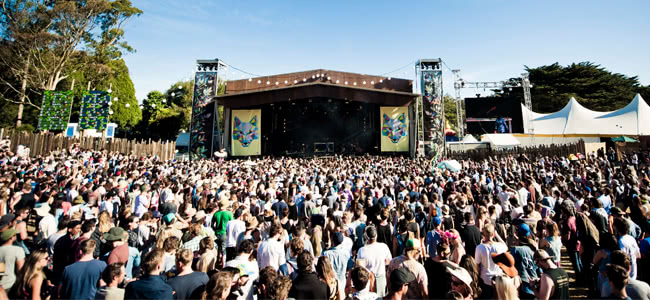On Friday night, at the Victorian leg of the Falls Festival, a large number of people attempted to leave the DMA’s set at the same time in order to see London Grammar at another stage. In the process there was a crowd crush which left 60 people injured – 19 of those seriously so – and forced organisers to end the evening’s program early. It’s the largest such incident in the history of Australian music festivals. Luckily, nobody was killed.
Falls Festival Co Producer Jessica Ducrou released a statement yesterday, saying the organisers are “beyond shattered” and “completely devastated”, citing “a confluence of events” as the cause, before promising “an investigation into the various contributing factors, which will take some weeks to determine.”
There will be an investigation, but there will be no easy answers available, and – most likely – no real solution.
—
At the 2001 Big Day Out in Sydney, as the audience lurched forward during nu-metal band Limp Bizkit’s incendiary set, 15-year-old Jessica Michalik was crushed, deprived of oxygen, and died five days later in a hospital. It was the first death at the BDO and the beginning of a stricter set of security practices across the industry.
Throughout both the media coverage and the legal proceedings, the absence of a D-barrier was pointed out repeatedly. A D-barrier is exactly what it sounds like: a D-shaped pen in front of the stage, designed to limit, and slow, the amount of people who entered the area. The idea is that less people means less of a crowd, and therefore less of a crush when the natural inclination to push forward results in a single-direction rush, momentum which is only stopped by fencing against which people can be – and often are – crushed, or by gravity. The D-barrier was implemented at the Big Day Out from 2002 onwards, and continues to be present at most large music festivals. In addition, many various types of other fencing is also used, mostly as a means of herding large of groups of people around the grounds without ever allowing for a dangerously-large amount of these people to congregate within one single space. It seems sensible. It probably is.
This fencing, while effective at keeping people from getting into an area, also limits the ways in which people can get out, once inside. If scheduling is sloppy at a festival where many punters have paid hundreds of dollars to see two bands who happen to playing in a row, but on different stages – there will be a rush to move from one area to another. If set-times overlap, this can often be compounded. There will be pushing, and bottlenecks, and anger, and alcohol. People aren’t patient, especially when they feel cheated, and if they want to get somewhere fast, they will try to hurry things up any way they know how. This can be tragic. Security cannot control tens of thousands of people, and when a collapse and a crush occurs in the middle of a sea of people, first aid will be delayed, the resulting confusion and fear will elevate the situation, people will push and rush even more, and incidents like what occurred at Falls will happen.
There is yet to be an inquest into this matter, and we can only rely on eye-witness testimonies at the moment, a lot of which will no doubt be coloured by shock, panic, and outrage. People want answers: Why was the only way worried relatives could find out information at the time via an email address with staggering poor response times? (Over four hours, according to one panicked Facebook commentator.) Why were punters unable to leave the venue after the incident? – and most importantly: How we can avoid something like this ever happening again?
There is no easy answer to that last question, at least probably not one that will satisfy those whose job it is to keep festival crowds safe, or those who were injured in the melee. No doubt Falls will be hit with even stricter barricade requirements; it happened after the 2001 Big Day Out, and it happened after nine people died during a Pearl Jam set at Roskilde in 2000. But will it help?
Could it actually be harmful to restrict punter access even more? Should we expect festival organisers to therefore limit crowds, implement large gaps between set times to avoid such timetabled panic, and as a result, book less acts – in essence scaling back these festivals which have grown organically, and with relative safety, over decades?
The truth is that sometimes people will push, people will panic, and a crowd crush is an impossible thing to avoid or to police once imminent. Maybe there is absolutely nothing to be done about this problem. But that doesn’t mean we shouldn’t continue to search for a solution. What happens next will be important.




































